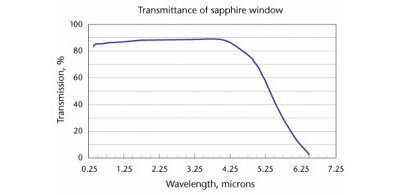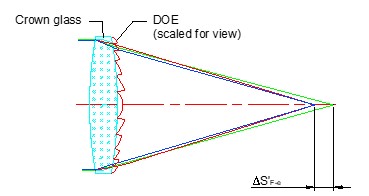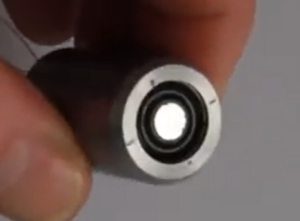Microscopy is a fundamental technique used to analyze samples that are too small to be perceived without magnification. It is used in multiple sciences, from biology, medicine, chemistry to anthropology, and any science where small samples are...
Blog
Uses of Sapphire explained; IR optics, laser optics, windows
by Victor Argueta | optics, science, Uncategorized
IntroductionYou may not be aware but you probably have in your hands one of the toughest substances in the world right now. If you own a good quality watch chances are that it has a sapphire glass. Also, some versions of Appla watches and almost all mobile phones use...
How to read an MTF chart
by John | optical engineering
Understanding the purpose of an MTF chart and how to read and MTF chart is an essential skill for anyone involved in the development of products that use optics.For most applications an MTF test is the single best method to determine lens quality. In this post we will...
Types of Optical Designs used for Rifle Scopes
by Victor Argueta | lens design, optical design, optics
Autumn is almost here and with that, hunting season. Hunting is so popular in my state that it is a non-official holiday where school is “canceled” and congress gets the day off. I’m not sure if that happens elsewhere but it is fair to say that hunting is a big part...
Achromatic doublet design and optimization
by Victor Argueta | lens design, optical design
Basic Concepts One of the most common optical structures is the achromatic doublet. It is used to reduce chromatic aberrations. At its most basic, it is a two lens system configuration where one lens is a concave lens, usually made of a flint glass, and the other is...
Which is better a CCD or CMOS image sensor?
by Victor Argueta | machine vision, optics
CCD vs CMOS CCD and CMOS are both image sensors. They can be found in any device that creates an image. Cameras, webcams, mobile phones. They are one of the most common consumer electronics in world. For many years there has been a debate about which image sensor: CCD...
Introduction to Interferometers, theory and design types
by Victor Argueta | optical engineering
Introduction to interferometry Interferometers are a family of optical systems that can be customized for a range of applications such as sensors to identify pathogens, detect liquid modifications due to pollutants or oxygen depletion, or aberrations caused by the...
Understanding Strehl Ratio in Optical Systems | OFH
by John | optics definitions
Understanding Strehl Ratio: A Practical Overview The Strehl ratio stands as a fundamental metric in optical engineering, providing a concise measure of the quality of an optical system in comparison to an ideal, aberration-free counterpart. This practical overview...
Laser Beam Homogenizer: Ensuring Uniformity in Laser Applications
by John | optical engineering
Introduction Laser beam homogenization is a pivotal technique in laser optics that aims to improve the uniformity and consistency of laser beams. In many laser applications, such as material processing, lithography, and medical treatments, the spatial intensity...
What is a rayset (rayfile) ?
by John | illumination lens design
A ray set is a optical model showing the path of millions of rays of light existing a source such as an LED
Is higher sensor resolution always better?
by John | optical design, resolution
An optical system is only as strong as its weakest link. When designing an imaging system, sensor resolution is just one important factor and it is important to ensure sensors and detectors are well matched. Take these scenarios: Taking a selfie with your cockadoodle...
Designing a custom spectrometer
by John | spectrometers
We will delve in more detail here on the types of questions we ask our customers when starting a spectrometer design program and the various stages of development. Some recent spectrophotometer development tasks included: Miniaturize a current lab prototype Automate...
Free multi-catalog lens search tool launched
by John | optical engineering, optics
Last week, we announced the launch of a free lens search tool for optical engineers. It is available at www.opticsforhire.com/lens-search The searchable database allows engineers working in robotics, machine vision, industrial, and security industries...
Launching a custom spectrophotometer design
by John | optical engineering
Spectrophotometers are an essential analytical tool used in many disciplines including biology research, chemical and clinical labs, medical imaging and biomarker testing. They are used to detect, identify, and quantify matters in solution, including DNA,...
Understanding Opto-Mechanical Design: Examples and Definitions
by John | lens design, opto-mechanical design
Opto mechanical design overview and definitions In an opto-mechanical design we work on the positioning of optical elements such as lenses, filters, beamsplitters, reflectors, and diffractive elements in mechanical structures that will allow the optical...
TIR Lenses, 3 basic design concepts
by John | FAQ, illumination
Working principle of TIR lenses: A TIR lens works on the principle of total internal reflection. When light reaches an interface between two materials with different refractive indices and the correct angle of incidence, there is refraction (bending of a light ray...
Steps for correcting chromatic aberrations in lens design
by John | optical design
In many applications of lens design, avoiding chromatic aberrations is a key performance requirement. In this video, we review some of the causes of chromatic aberrations and methods to correct them. •All optical media have dispersion, meaning the index of...
Understanding image depth of field
by John | optics definitions
Depth of field is a distance range where the image optical resolution is as high as possible for that lens, i.e. an image appears to be in focus. When starting a lens design program, having a good understanding of this parameter’s physics will help you and your...
3 key focus tunable lenses technologies
by OlegRybakovsky | optical design
Updated July 2020. Most visual imaging applications require a well-focused image at a range of distances. Traditionally, good focus at multiple depths required either using large lenses with a suitable depth of field, mechanically-driven zoom, or auto-focus lenses....
Anamorphic lenses
by OlegRybakovsky | Uncategorized
There are two lens classes that can be used in film making - spherical and anamorphic. Spherical lenses are more common and have wider applications. A rectangular film gate or imaging sensor area acts as the field stop determining both the field of view (FOV) angular...






















